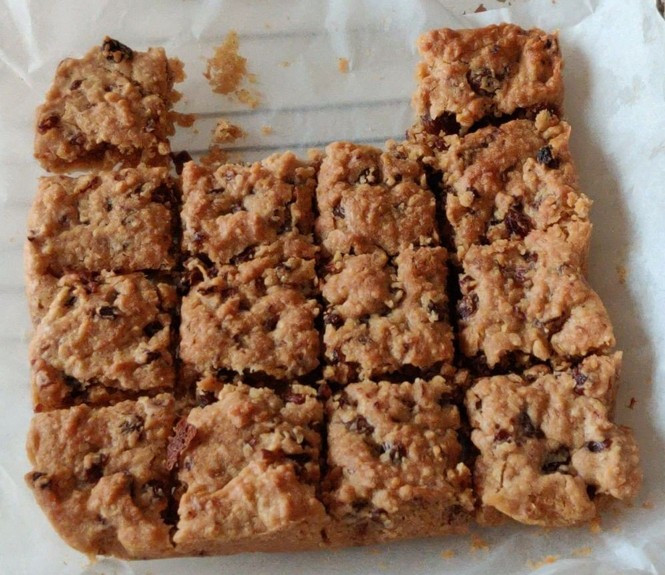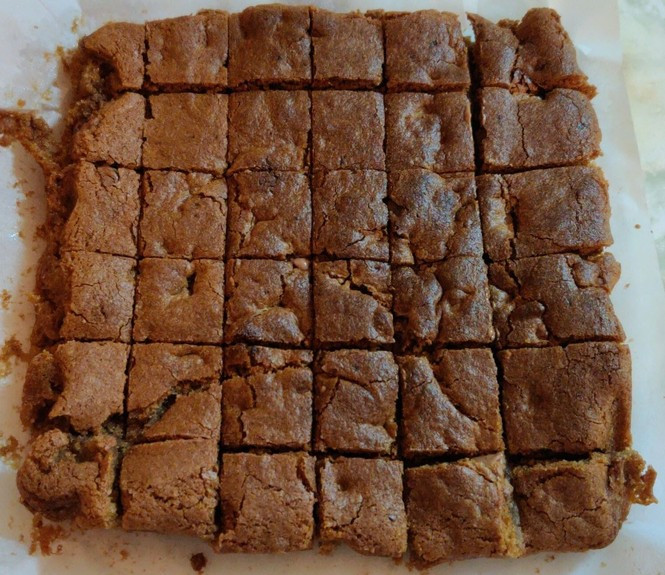I recently tried a recipe I watched Jamie Oliver make on “Jamie’s Quick and Easy Food”. It presented a minor challenge, because all the measures were in metric units, a different system than that to which I am accustomed to using while cooking.
The recipe I tried is “Buddy’s Flapjack Biscuits” (a type of oatmeal-raisin square) found at https://www.jamieoliver.com/recipes/oat-recipes/buddy-s-flapjack-biscuits/ (here’s my archive) (here’s my recipe based on Jamie’s recipe).
Incidentally, I have since also made a somewhat similar recipe called “Blondies”, which I found at https://joyofbaking.com/barsandsquares/Blondies.html (here’s my archive) (here’s my recipe). Although it is still in either American or Imperial units, it also provides conversions in metric units (see below).
I live in Canada, which has been officially metric since a phase-in period spanning from 1970 to 1985.
However, in Canada, we also deal with at least two traditional systems of measurements, in addition to the metric system:
- Imperial Measurements (English Units) originating from the British Isles, because of historical ties from colonial times; and,
- The United States Customary Units, which are derived from the British Imperial Measurements, and which are really important in Canada because the United States is Canada’s largest trading partner.
This means that in Canada, we regularly albeit informally deal with what could be described as a complex hybrid of (at least) three measurement systems. Although the Imperial System (English Units) has been slowly fading for decades, it has also kept a strong hold on things, such as through old measuring cups and other implements used in home kitchens, often inherited from parents and grandparents. The US Customary Units also have a very strong influence on Canada, especially since the units usually have identical names as their counterparts in Imperial units, as well as very similar though distinct measures.
In my personal experience, listing all ingredients in all home recipes in metric is uncommon in Canada, despite metrication back in the 1970s. In my personal experience, we still list ingredients in quarts, cups, ounces (both liquid and weight), teaspoons, tablespoons, and the like. This of course is complicated by some things like “new” pots being in litres, as well as things like jars, both of the mason and commercial product varieties, which are in millilitres and litres (while my pickled eggs recipe is based on Imperial units, for instance.) In any case, when food weights come into play, I usually I know how to estimate them, such as “about a pound of chicken or ground beef” (follow the weight on the package to help estimating), or a given number of pounds of potatoes, coming out of a bag that is known to contain 10 pounds of potatoes.
As mentioned above, many measuring cups and other kitchen implements are still in Imperial or American measurements, although some newer measuring cups (of which I do not possess save the one mentioned below) and other kitchen implements are also marked in Metric units, in addition to either Imperial or American units.
So, back to baking the squares: This is the second time I have followed one of Jamie’s recipes. The first time, several years ago, I guesstimated conversions. I was fortunate a few weeks later to find a glass measuring cup with multiple scales printed on its sides, each for different ingredients, such as flour, sugar, starch, rice, and the like, and showing graduations in grams for the given ingredient. In retrospect, I perhaps should have been searching for a kitchen scale instead. In any event, I largely forgot about the measuring cup after having used it once or twice.
When I was preparing to make Buddy’s Flapjack Biscuits, I had a minor problem. Since I had forgotten about the measuring cup with scales in grams, and I don’t have a kitchen scale, I couldn’t simply weigh out the ingredients (20230628: I bought a kitchen scale by August of 2020, a few months later, as described in this post). I had to convert the measures of Jamie’s list of five ingredients, composed of 100g of each ingredient. No doubt making each exactly 100g was an intentional novelty added to the original recipe, as well as, of course, being an easy way to remember how much of each ingredient to use.
In the process, I was reminded of a confusing reality of which I’ve been aware all my life: I navigate the above-mentioned three measurement systems, often without thought, almost on a daily basis. To wit, I found a website that converted 100g of flour to close to 2/3 cup in Imperial units, and close to 3/4 cup in American units. I didn’t immediately know which to choose. (20230628: here is a site with the difference between a “Canadian” cup and an “American cup, with my archive.)
I did remember at this point that I had the glass measuring cup with the various scales. I determined that 100g of flour was equal to about 2/3 cup in one of the kitchen measuring cups I have. I guessed that at least with said measuring cup, I would also need to measure to 2/3 cup each for oats and raisins. I was able to determine that golden syrup, through a recipe found on the internet, is almost completely composed of sugar, and in fact has very little water in it. Again using the glass measuring cup with multiple scales, I measured out 100g of plain sugar, and found that it is about 1/4 cup in my regular measuring cup; I chose to use brown sugar in the recipe I developed, and added one and a half tablespoons of water in order to simulate the effect of the liquid nature of golden syrup. An online conversion revealed that 100g of margarine was also about 1/2 cup.
But I am now finding it dissonant that I can’t be certain what the real capacities of each of my multiple measuring cups are, nor for which system (Imperial or American) each were designed. I would only ultimately know by securing a kitchen scale (for dry goods), or securing a graduated cylinder (for liquids), to systematically measure each and every measuring cup I have. Perversely, graduated cylinders to which I would have access are graduated in millilitres, a metric measurement.
And what about the squares? “Buddy’s Flapjack Biscuits” are nice enough, although I think that there are too many oats. On the other hand, my mom likes them a lot. The “Blondies“, as their name may well suggest, are scrumptiously like a chocolate chip cookie version of brownies. Hence both have earned a place in my collection of recipes.


